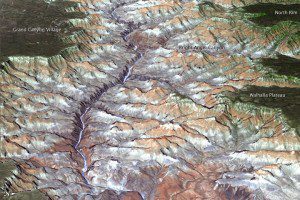The image at left shows the eastern part of Grand Canyon National Park in northern Arizona, near 36 degrees north latitude and 112.1 degrees west longitude. It is a composite of two pieces: a synthetic natural color image captured on July 14, 2011, draped over a 3-D model of the area. The images and stereoscopic data behind the model were acquired by the advanced spaceborne thermal emission and reflection radiometer (ASTER) sensor on NASA’s Terra spacecraft.
The perspective is from east to west, looking down the channel of the Colorado River. North is to the right. In this view, the canyon spans 9 miles (14.5 kilometers) at its widest point and 5,600 feet (1,707 meters) from rim to riverbed. The North Rim and Walhalla Plateau stand out on the right side, while Grand Canyon Village rests on the high plateau at upper left.
On Oct. 17, 2011, NASA and Japan’s Ministry of Economy, Trade and Industry (METI) released a significantly improved version of a digital topographic map of Earth based on data from ASTER. Known as a global digital elevation model, the map was created from stereo-pair images; that is, sets of two slightly offset 2-D images were merged to create the 3-D effect of depth.
NASA and METI released the model's first version in June 2009. The 2011 version adds 260,000 stereo-pair images to improve spatial resolution, increase horizontal and vertical accuracy, and provide more realistic coverage over water bodies. ASTER uses 14 spectral bands (from visible to thermal infrared wavelengths) and spatial resolution of 15 to 90 meters (about 50 to 300 feet) to map 99 percent of Earth’s landmass from 83 degrees north latitude to 83 degrees south.
Click here for more details on the new topographic map.
NASA image provided courtesy of the NASA/GSFC/METI/ERSDAC/JAROS, and U.S./Japan ASTER Science Team.
Caption by Michael Carlowicz and Alan Buis.


